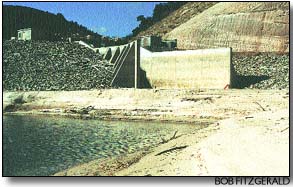|
November 8, 2001
By Jim Mimiaga Unseasonably warm and dry weather in the Four Corners this fall is wreaking havoc on reservoir supplies, wildlife activity and the upcoming ski season. As mid-November approaches, Cortez has seen consistently balmy days, with some reaching upwards of 70 degrees. Precipitation has been negligible, with year-to-date moisture levels below normal for the year. "Right now, weíre 60 percent of normal for precipitation," said Dan Fernandez of the Colorado State ag extension office on Wednesday. "This time of year we should have had 11.9 inches of rain so far, but to date we have only seven inches of rain total" for the year. In October, the region received 0.15 inches of rain. So far in November, there has been no recorded moisture for Cortez.
Blame the delay in snow storms on a weather phenomenon dubbed "a polar vortex trough," which is currently parked over the Gulf of Alaska, according to Paul Frisbie, a forecaster with the National Weather Service in Grand Junction. "Itís basically a very big high-pressure system that stretches south along the Rockies, effectively blocking storms from entering the area," Frisbie explained. More of the same is expected, he said, but the dry high-pressure pattern will eventually break up and let the white gold through. Currently, Pacific storms relied on by Southwest Colorado ski areas are petering out in Nevada and Utah, "but when the jet stream drops south, as it typically does, expect the snow to fall," Frisbie said. Right now the jet stream is flowing through the Pacific Northwest, then north into Canada. Two years of below-average moisture levels are showing up as vastly expanded shores on McPhee Reservoir. Capacity is at its lowest level since the reservoir filled in 1987, reports John Porter, general manager of the Dolores Water Conservancy District. Active capacity is at 53,744 acre-feet currently, the lowest on record. This time last year, active capacity was at 65,767 acre-feet. As a comparison, in 1999 the reservoir had an active capacity of 175,739 acre-feet in November. "That difference of 121,925 acre-feet is about a yearís supply of normal use of the reservoir," Porter said. Itís too soon to guess whether there will be shortages administered next irrigation season as a result of multiple dry years, Porter said. Such a situation has never occurred since McPhee filled. But with record lows two years in a row, it is becoming a concern. Shortages, if required, are shared among DWCD irrigators and a water pool reserved for the downstream fishery. Municipalities, however, do not suffer shortages and always receive their full share regardless, Porter said. "It is too soon to estimate on that anyway," he said. "All we can do is hope for the best." The balmy weather is having an effect on wildlife as well as area citizens. Warmer weather can disrupt black-bear hibernation patterns, depending on the food source, said Robin Olterman of the Division of Wildlife. "Being so warm may cause them to roam around a little bit more, but if there is no food then hibernation will automatically begin even if it is not real cold," Olterman said, adding that "this year was tough on bears" because one of their main foods, the acorn crop, was destroyed by an early spring frost. The low reservoir is also reducing the Kokanee Salmon run up the Dolores River this year, biologists say. Silty and shallow waters limit the annual spawning activity because the fish get confused and stay in the reservoir. Reduced salmon, means fewer bald eagles perched on cottonwoods lining the upper Dolores River. During normal years the stately raptors arrive by the dozens to feast on salmon as they spawn upriver. Telluride, Durango Mountain Resort and Ski Hesperus all are reporting skimpy snow packs. Durango Mountain Resort is already making snow, and, according to observers, its been raining in Telluride, but not much snow is sticking on the slopes, which are scheduled to open Nov. 20. |
||||
|
Copyright © 2001 the Cortez Journal.
All rights reserved. |
